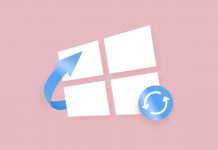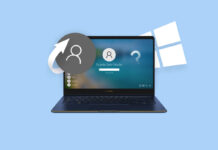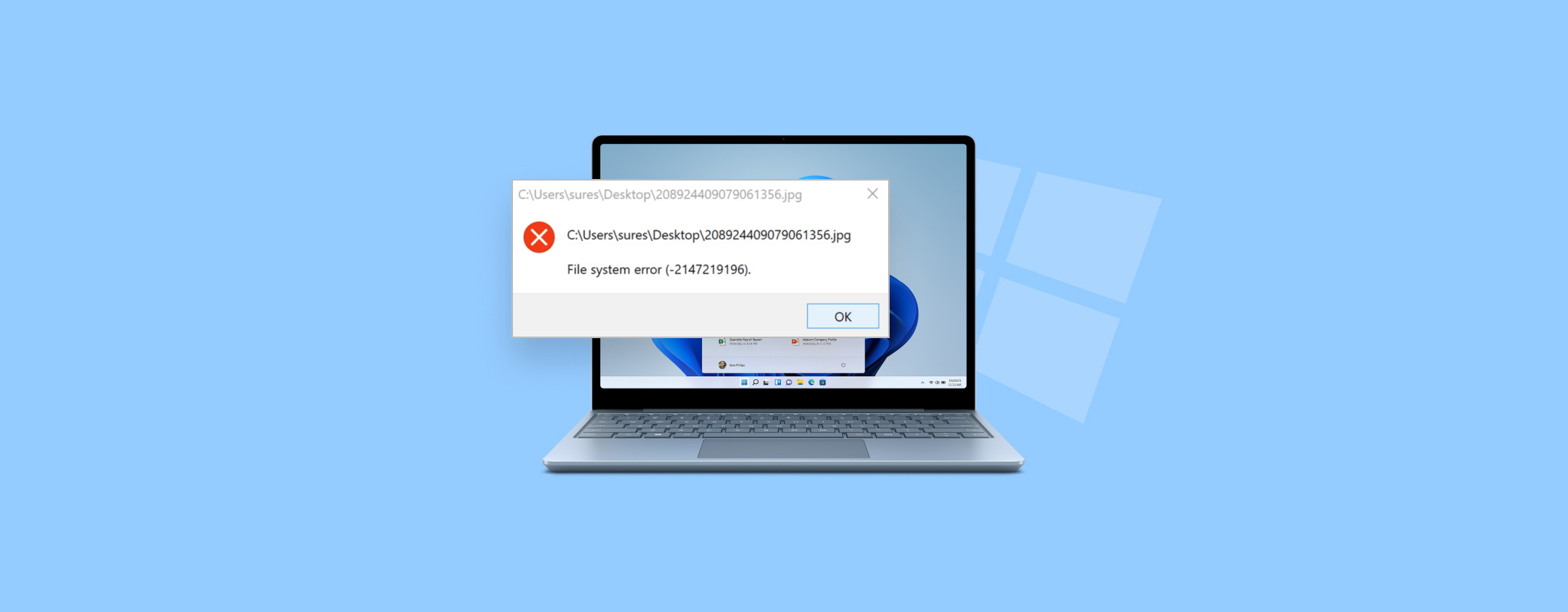
If you opened this article, you’ve probably seen a message on your PC saying something like “File system error” followed by a random set of numbers, and now you’re trying to figure out how to get rid of it, right? Or maybe you’re just curious to learn more about how Windows works and want to be prepared in case this problem ever shows up.
There are many different types of file system errors, and they can appear at random for various reasons. Fortunately, file system errors are nothing new, and there are proven ways to get your computer back to normal. Either way, you did the right thing by landing here. In this guide, we’ll explain how to fix a file system error in Windows 11 (and Windows 10). So, keep reading.
What Is a File System Error?
Sometimes, Windows runs into trouble when handling your files and that’s when a file system error pops up. It usually happens while you’re doing something ordinary, like opening a document, launching a program, or saving a file to your drive. In short, it appears the moment Windows tries to access the part of storage that’s acting up. The tricky part is that these problems don’t always show up right away. A disk sector might fail quietly, or a Windows update might leave behind a corrupted component, and you’ll only find out days or even months later (right in the middle of your normal routine).
There are many possible reasons why these errors occur, from Windows updates and damaged sectors to missing certificates or corrupted files. But don’t worry too much about what exactly caused it. The main goal is to fix the issue, not to blame yourself for doing something wrong.
There’s a long list of error codes that can appear with file system errors in Windows 10 and 11. We’ve listed the most common ones below to show you what file system error really means, and how different codes relate to different types of issues:
| Error code | Description |
| -2143322101 | This error can appear when you have an issue with your PC Game Pass or Minecraft Launcher. |
| -2147219196 | This is a Photos file system error that appears when you try to open a photo or video using the Photos app. |
| -789839862 | This is an NTFS file system error code associated with the Settings app on Windows 10 and 11. |
| -1073741521 | When you have a problem with a Microsoft Store app on Windows 10 or 11, this file system error code may appear. |
| -1073741818 | If you don’t have admin access and attempt to open an app that requires administrator privileges, this error can appear. |
You might run into other error codes that aren’t listed here, and that’s fine, the methods below include both targeted and universal fixes. So don’t stress out, if your PC still turns on (and hasn’t met the wall yet), you’ve got every chance to fix it.
Create a Backup Before Fixing the File System Error
Even though a file system error doesn’t always mean you’ve already lost data, some of the fixes that come later in this guide (especially the ones closer to the end) might. And while data recovery is usually possible after the fact, we’re fans of the more preventive approach – taking care of it before anything goes wrong. That way, you can troubleshoot safely without worrying that a random document or photo might vanish in the process.
Windows already includes built-in backup tools like File History and Backup and Restore. If you’re comfortable using them, that’s perfectly fine. We prefer a more flexible option, using a dedicated backup tool. Our go-to choice (and the one we use ourselves) is Disk Drill.
Disk Drill lets you create a byte-to-byte backup of your system and later recover any data from it. Thanks to its full file-system support, you don’t have to worry about losing something important, it can bring back everything you need.
- Download and install Disk Drill on your computer, then launch the program.
- From the sidebar, select Byte-to-byte Backup.
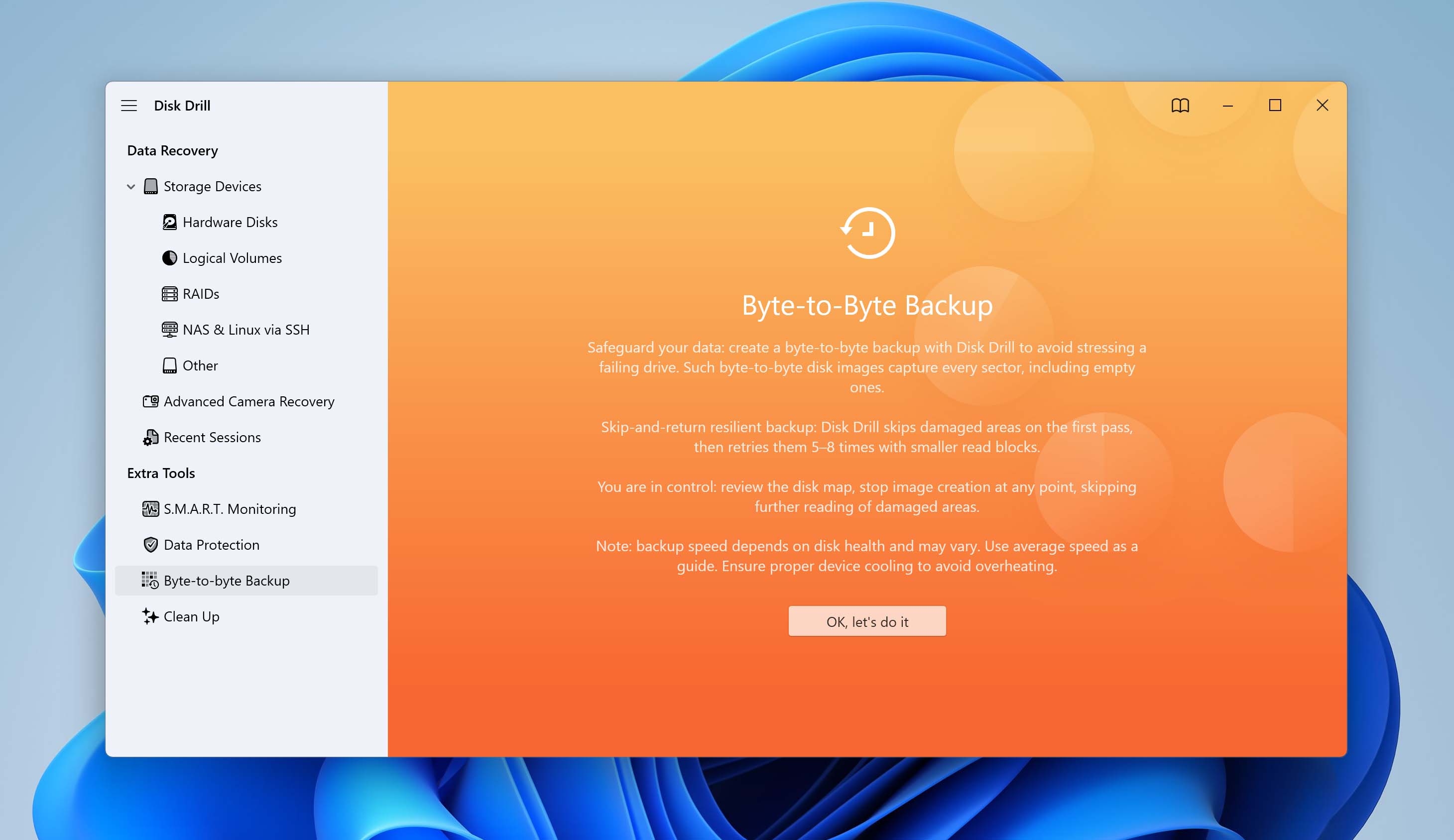
- Choose the disk or storage device you want to back up from the list, then click Create Byte-to-byte Backup.
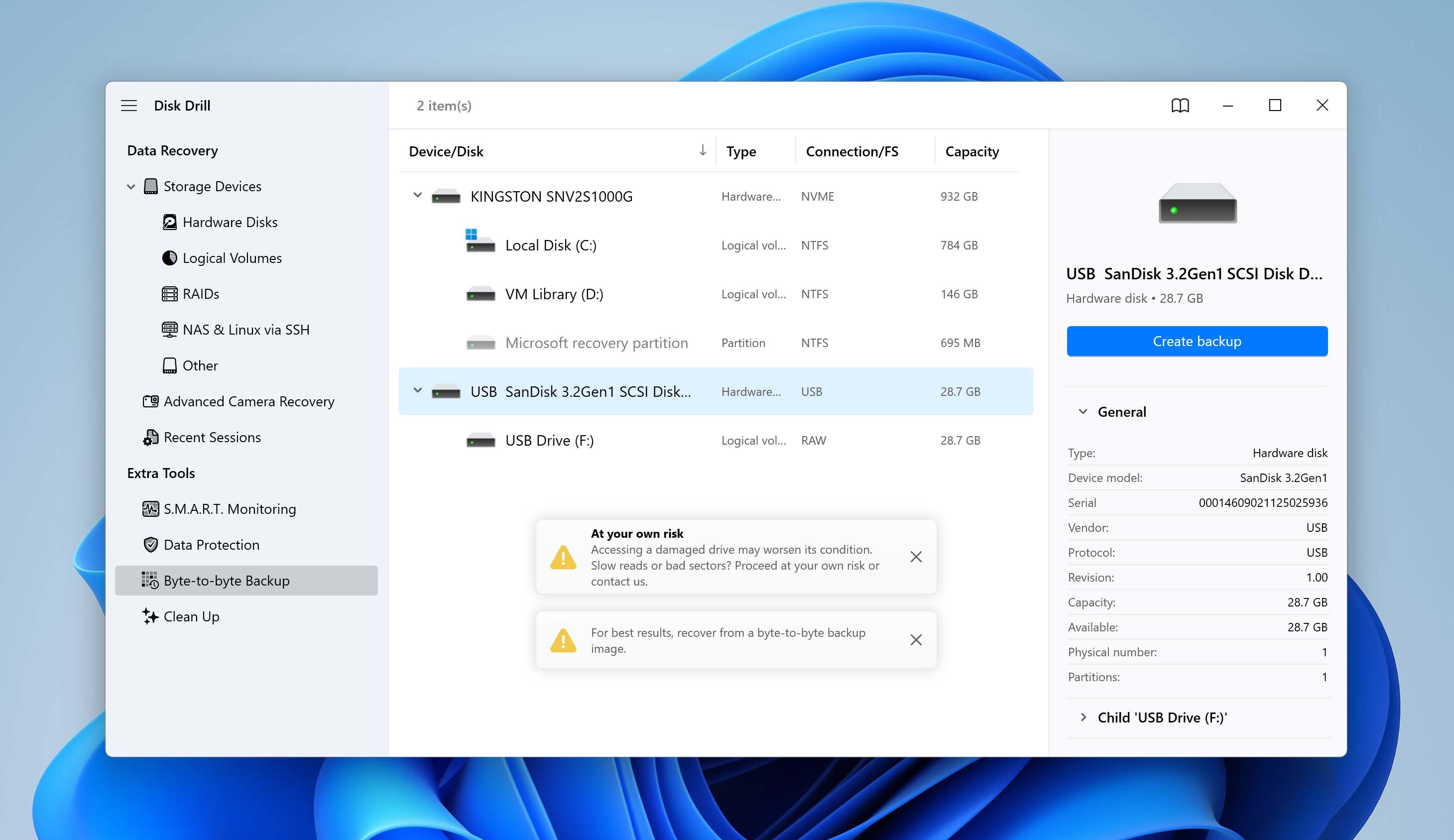
- Select the destination folder where you want to save the backup file. (We recommend connecting an external drive, like an SSD or HDD, to store it safely.) Click OK and wait until the process finishes.
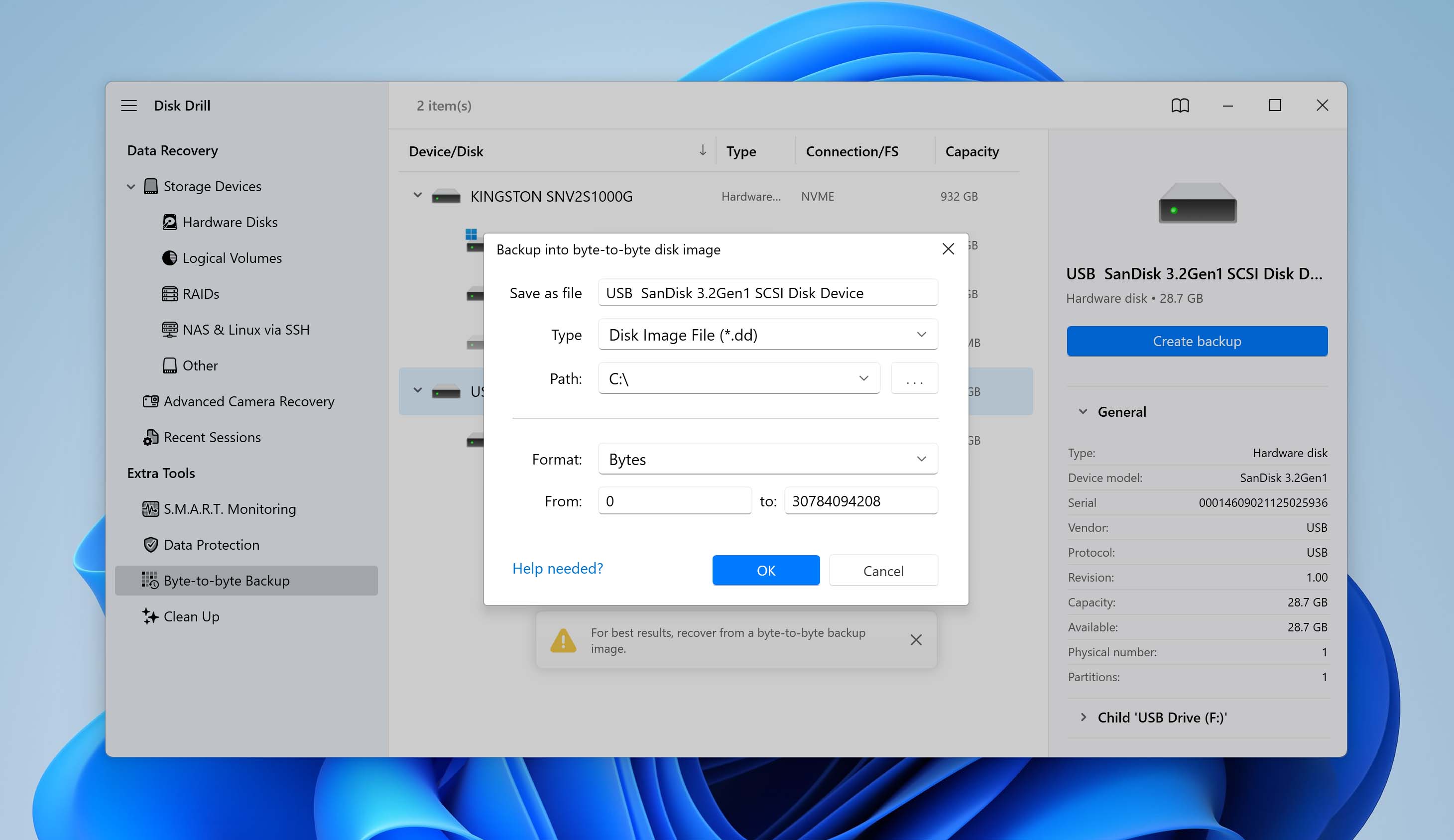
- Once the backup is complete, you’ll find the new disk image file (with the .dd extension) in the folder you selected.
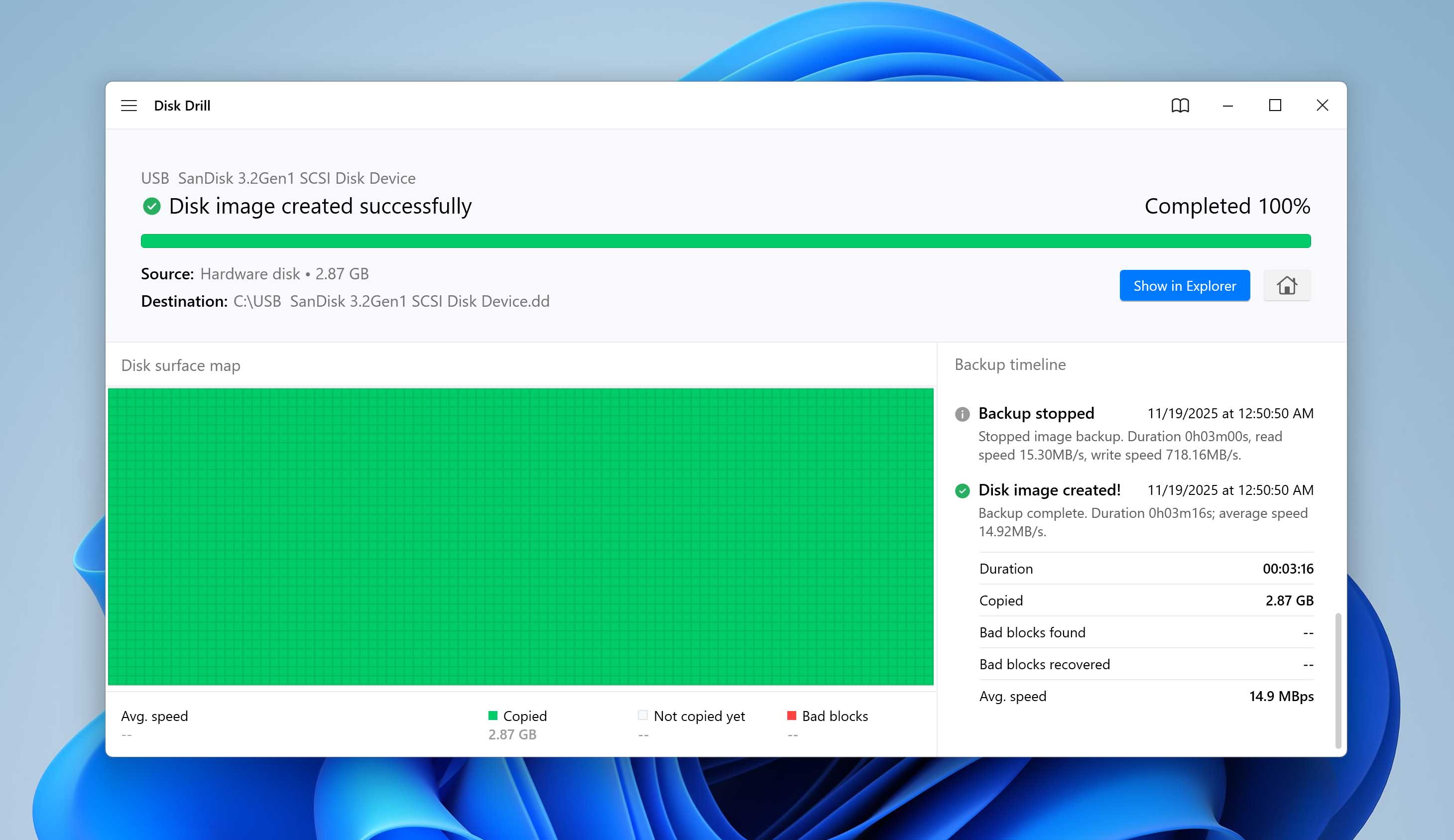
At this point, you can close the program and move on to the next section – how to fix the file system error. If something goes wrong and you lose any data, you can always come back to this backup and use it for recovery.
To save you from jumping back and forth between sections, here’s how to recover files from the backup right away:
- Open Disk Drill (if it’s closed) and go to the Storage Devices tab.
- Click Attach the disk image on screen bottom, then select ot from devisw list and click Search for lost data.
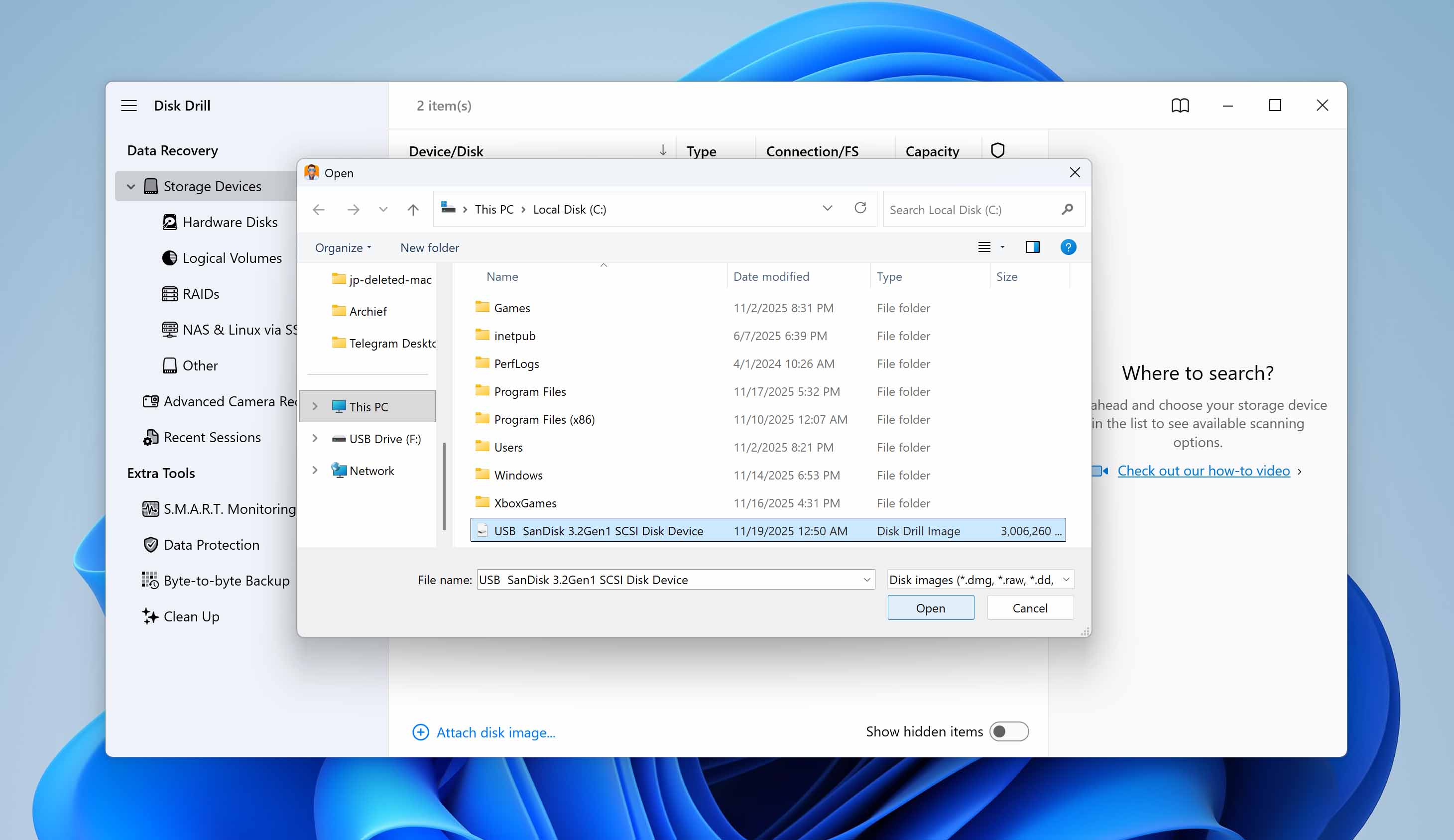
- Wait until the scan finishes and click Review found items to see what Disk Drill detected.
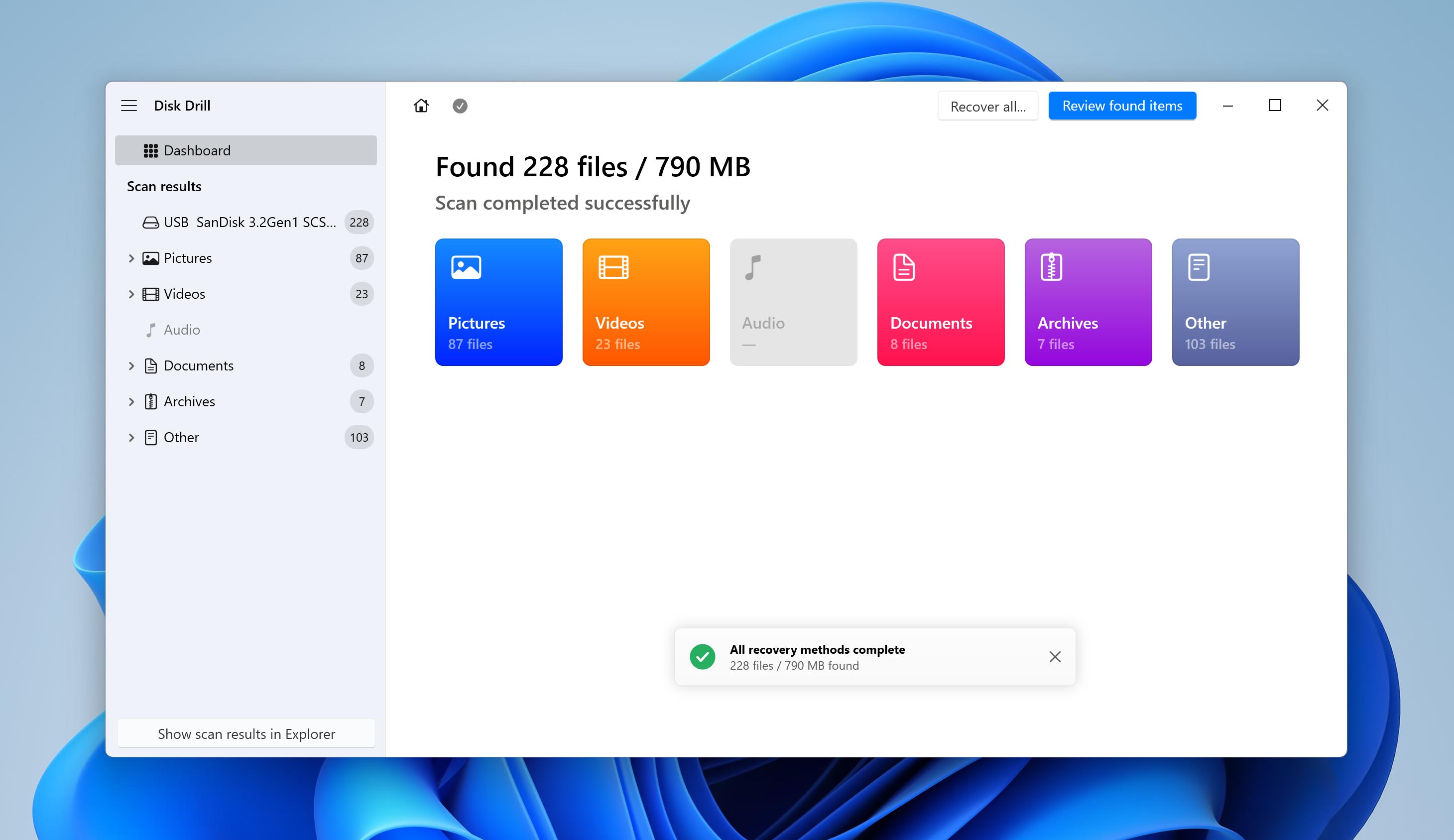
- Use the Preview panel, select everything you want, then click Recover.
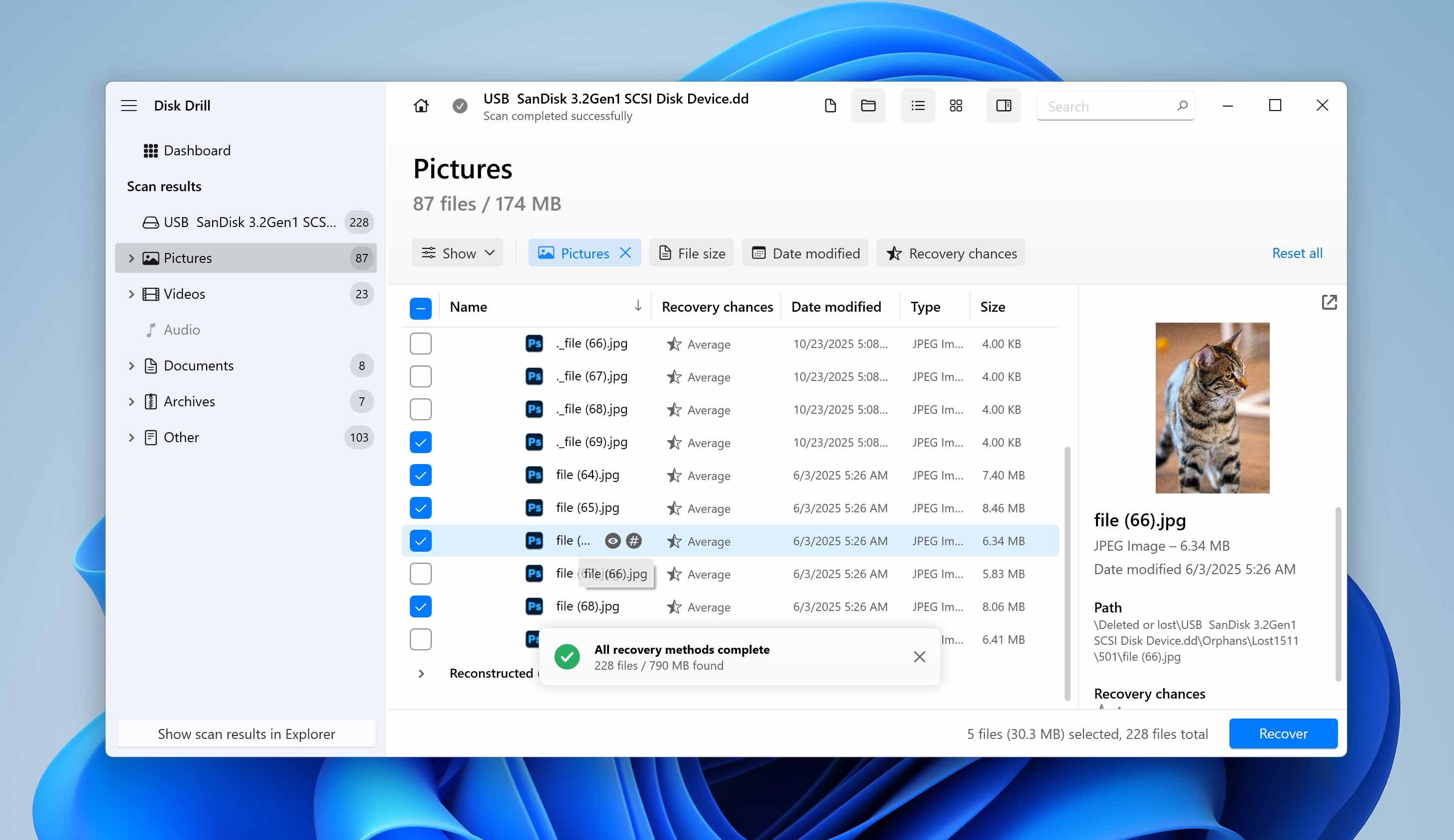
- Choose a different location for recovery, but never save files back to the same disk you’re restoring from, as it can overwrite them. Click Next, and you’re done.
You can download Disk Drill for free and use it to create a byte-to-byte backup, scan your drive or backup image. The free version lets you recover up to 100 MB of data, which is more than enough to test how the app works and see if it meets your needs before upgrading to the Pro edition.
How to Fix a File System Error?
Now that your data is backed up and safe, we can move on to fixing the file system error, whatever form it takes. The methods below cover different cases: some are broad, system-wide fixes that can solve multiple types of errors, while others target specific issues.
Before you start type the Terminal commands or open system settings, take a quick look through the full list of methods. You might spot one that matches your situation exactly. If not, just start from the top and work your way down, one of them will do the trick eventually.
If you’re unable to boot into Windows with admin rights, you can instead boot into Windows Recovery Environment (WinRE) or use a bootable version of Windows.
Method 1: Restart Your PC
As silly as it might sound, restarting your computer really can help.
- Click Start, select Power, and choose Restart.
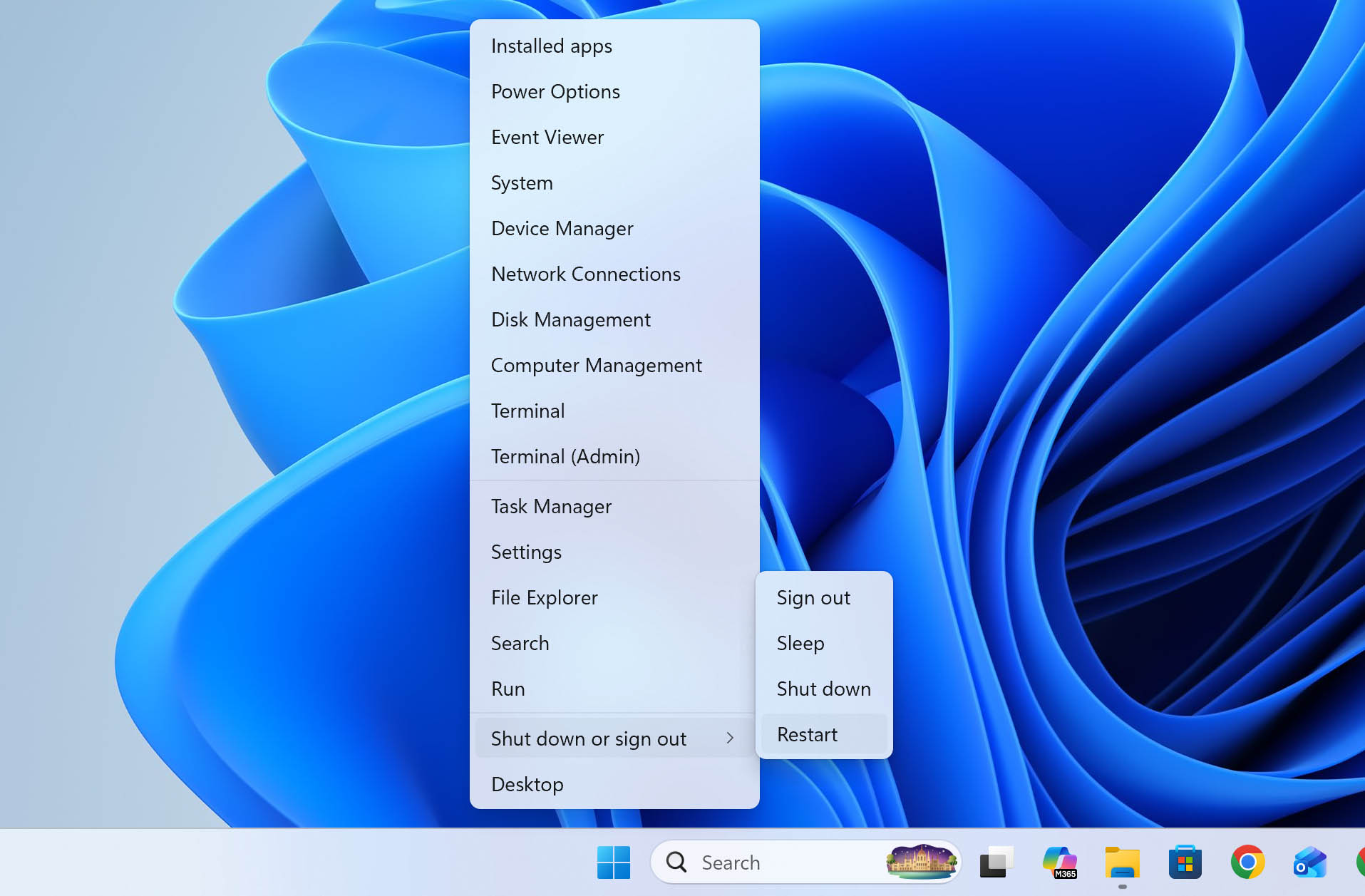
- Wait for Windows to shut down and start again completely.
- Once your PC is back on, try repeating the same action that originally triggered the file system error (open the same app, file, or folder).
If the message doesn’t appear this time, great, you’re done for now. If it still pops up, move on to the next method in the list.
Method 2: Run SFC and DISM
Damaged or missing files often trigger file system errors, and Microsoft actually includes two built-in tools designed to repair them.
[ Sometimes you’ll see these tools listed separately, but we recommend running them together (SFC first, then DISM) since they complement each other and cover different layers of the system.
What these tools do:
- SFC (System File Checker) scans your system for corrupted or missing files. If it finds any, it automatically replaces them with clean versions stored locally.
- DISM (Deployment Image Servicing and Management) repairs the deeper Windows system image itself, fetching the necessary files from Windows Update. (That means you’ll need an active internet connection for DISM to work.)
- Right-click Start and click Terminal (Admin).
- Type sfc /scannow and press Enter. Wait until the scan completes. If the issue persists, go to the next step.
- Type dism.exe /online /cleanup-image /restorehealth and press Enter.
- Once both commands finish, restart your computer.
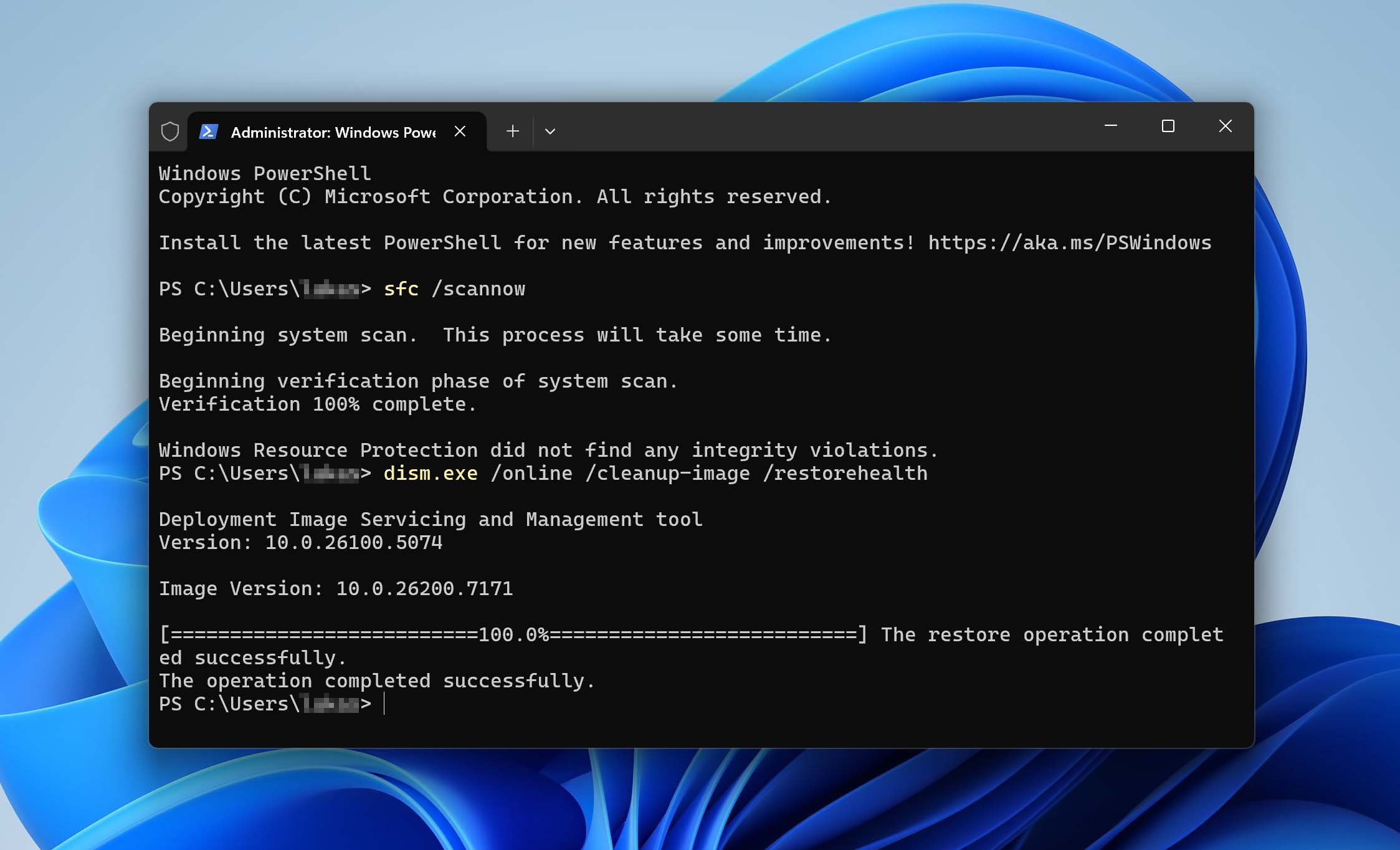
Method 3: Run CHKDSK
If the previous commands didn’t solve the problem, don’t close the Terminal just yet, it’s time to try CHKDSK. On its own, CHKDSK simply checks for errors and reports them back. But with the right parameter, it can also fix them (depending on the parameters you use).
In this guide, we’ll use the /r parameter. It combines the repair features of /f (fixes disk errors) with the added ability to locate bad sectors and recover data from them.
[ You can find a full list of CHKDSK parameters and their descriptions on Microsoft’s official site, but for most cases, /r will be enough.
Here’s how you can run CHKDSK to fix file system errors:
- Right-click Start and click Terminal (Admin).
- Type chkdsk *: /r. Replace * with the drive letter of the affected drive and press Enter.
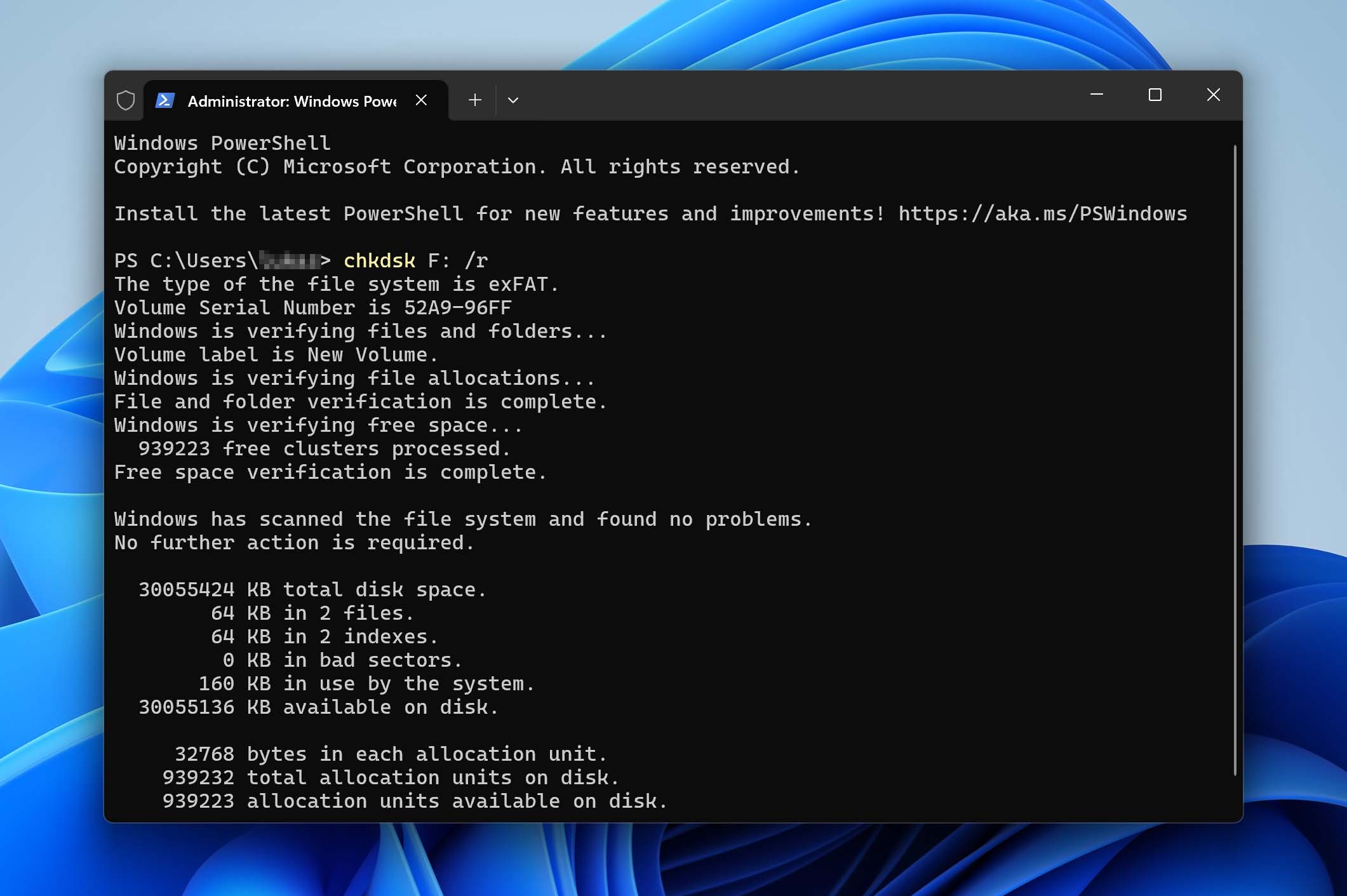
- If prompted to schedule the scan on the next restart, type Y and press Enter. Restart your computer to let CHKDSK run and repair your drive.
Method 4: Reset the Microsoft Store Cache
Sometimes, a file system error appears because the Microsoft Store or one of its apps fails to load cached data properly (this cache can become corrupted, especially after Windows updates or interrupted downloads). When that happens, you might see file system errors linked to built-in apps like Photos, Xbox, or even the Store itself.
Resetting the Microsoft Store cache clears all temporary data that may be causing the problem. Still, it doesn’t delete your installed apps or affect your account, just forces Windows to rebuild the Store’s internal files and settings.
Here’s how to do it:
- Press Windows + R on your keyboard to open the Run dialog.
- Type wsreset.exe and press Enter. A blank Command Prompt window will appear for a few seconds, so don’t close it.
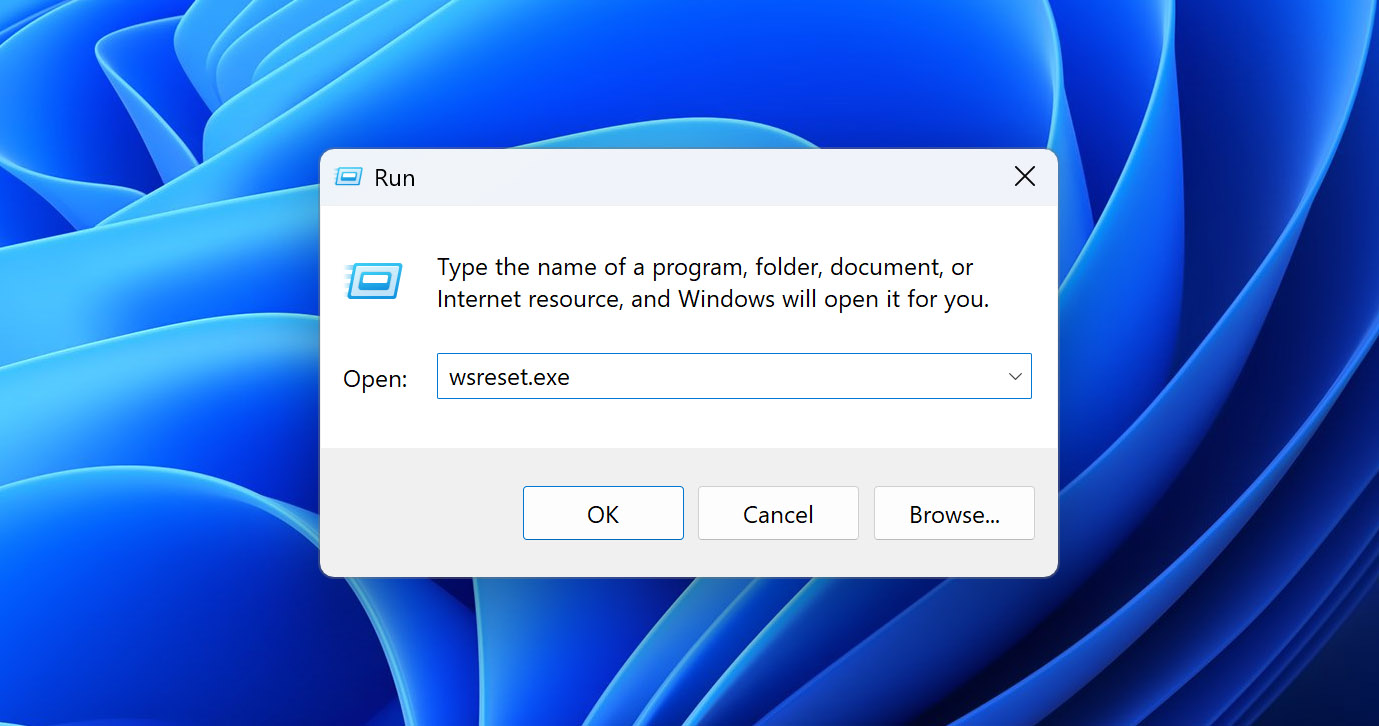
- Once the process completes, the Microsoft Store will launch automatically with a fresh cache.
Method 5: Check Windows License Manager Service
If clearing the Microsoft Store cache didn’t help, the issue might be with one of the background services that run Store apps. The Windows License Manager Service is one of those. It handles app licensing and activation in the Microsoft Store.
Unlike many other Windows services, it doesn’t always start automatically (it only runs when requested by the system or a specific app). If it’s been disabled, Microsoft Store apps may stop launching or show unexpected file system errors.
To fix this, make sure the service is set to start automatically:
- Open Start and search for Services, then open it.
- Scroll through the list and double-click Windows License Manager Service.
- In the Startup type dropdown, select Automatic. If the service status shows Stopped, click Start.
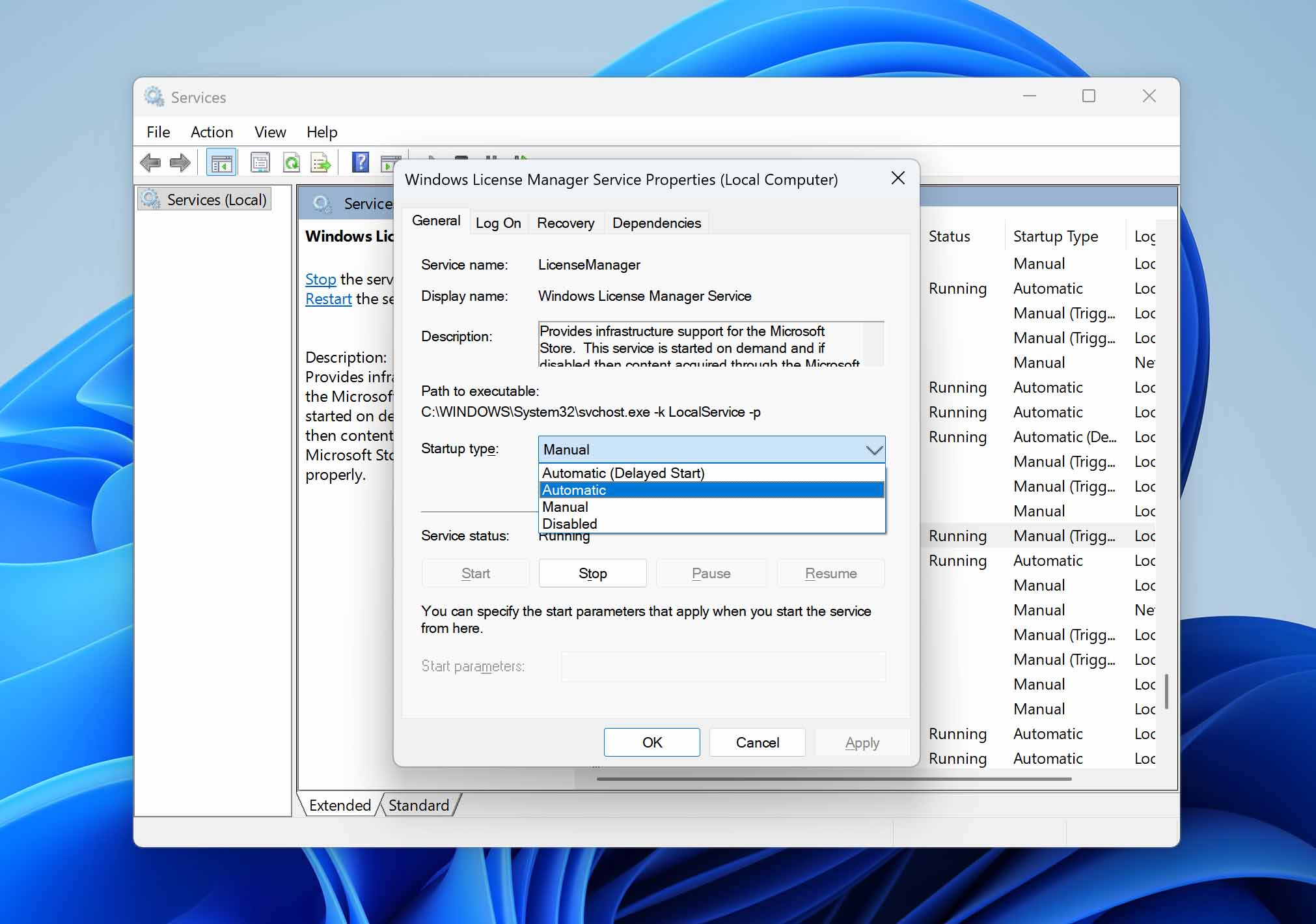
- Click Apply, then OK to save the changes. Once done, restart your computer and try opening the problematic app again.
Method 6: Repair or Reset the Problematic App
You can also repair or reset the app that’s showing the file system error. This works well when a specific program, like Photos, Mail, refuses to launch, crashes on startup, or throws the same error code every time.
Windows lets you do this without uninstalling the app completely. The Repair option checks for missing or corrupted files and restores them without touching your data. The Reset option goes further, and returns the app to its original state, erasing its settings and cache but keeping it properly installed.
Here’s how to use these options:
- Right-click Start and select Installed apps.
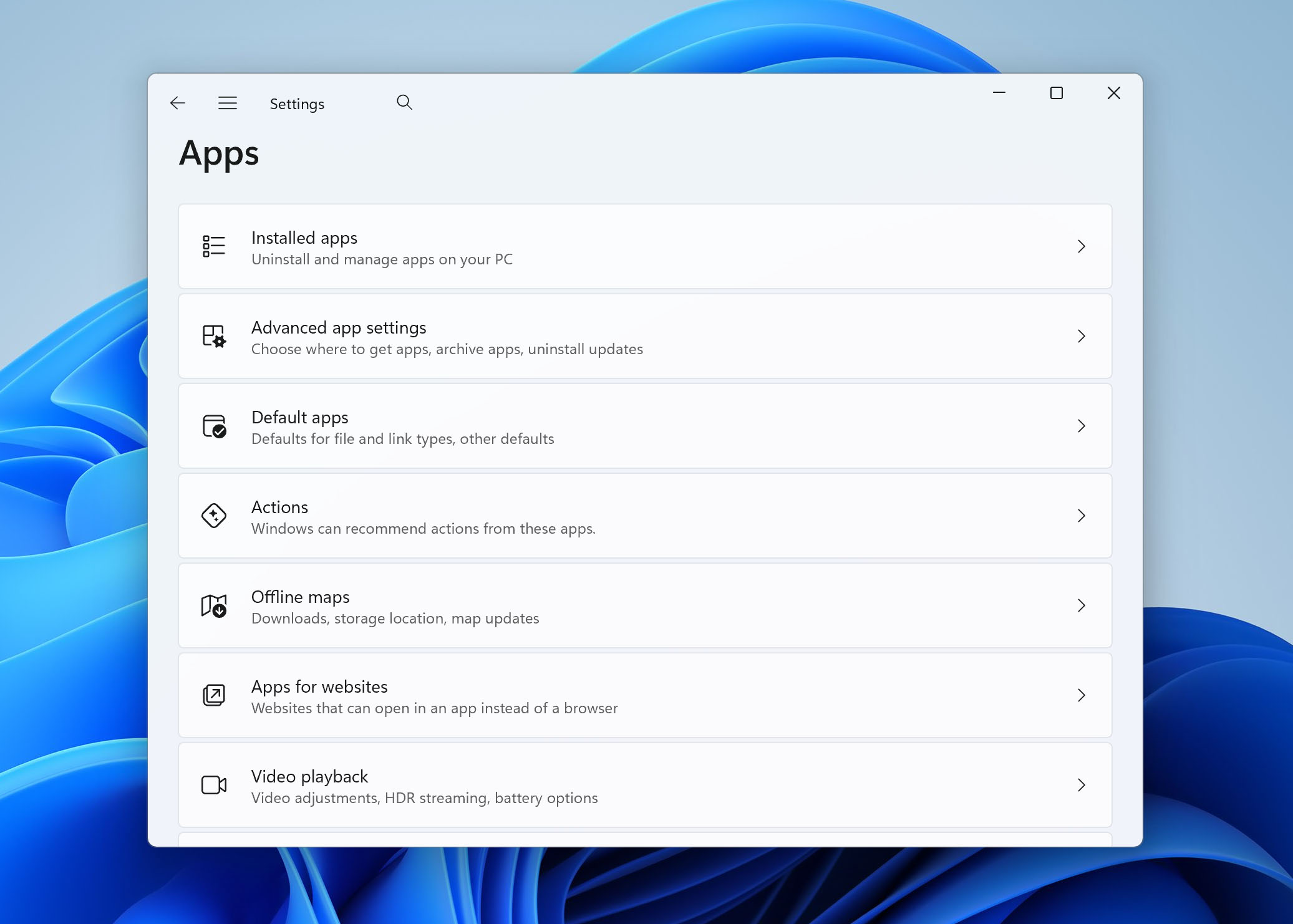
- Find the app that’s causing the problem and click the ellipsis (⋯) button next to it. Choose Advanced options.
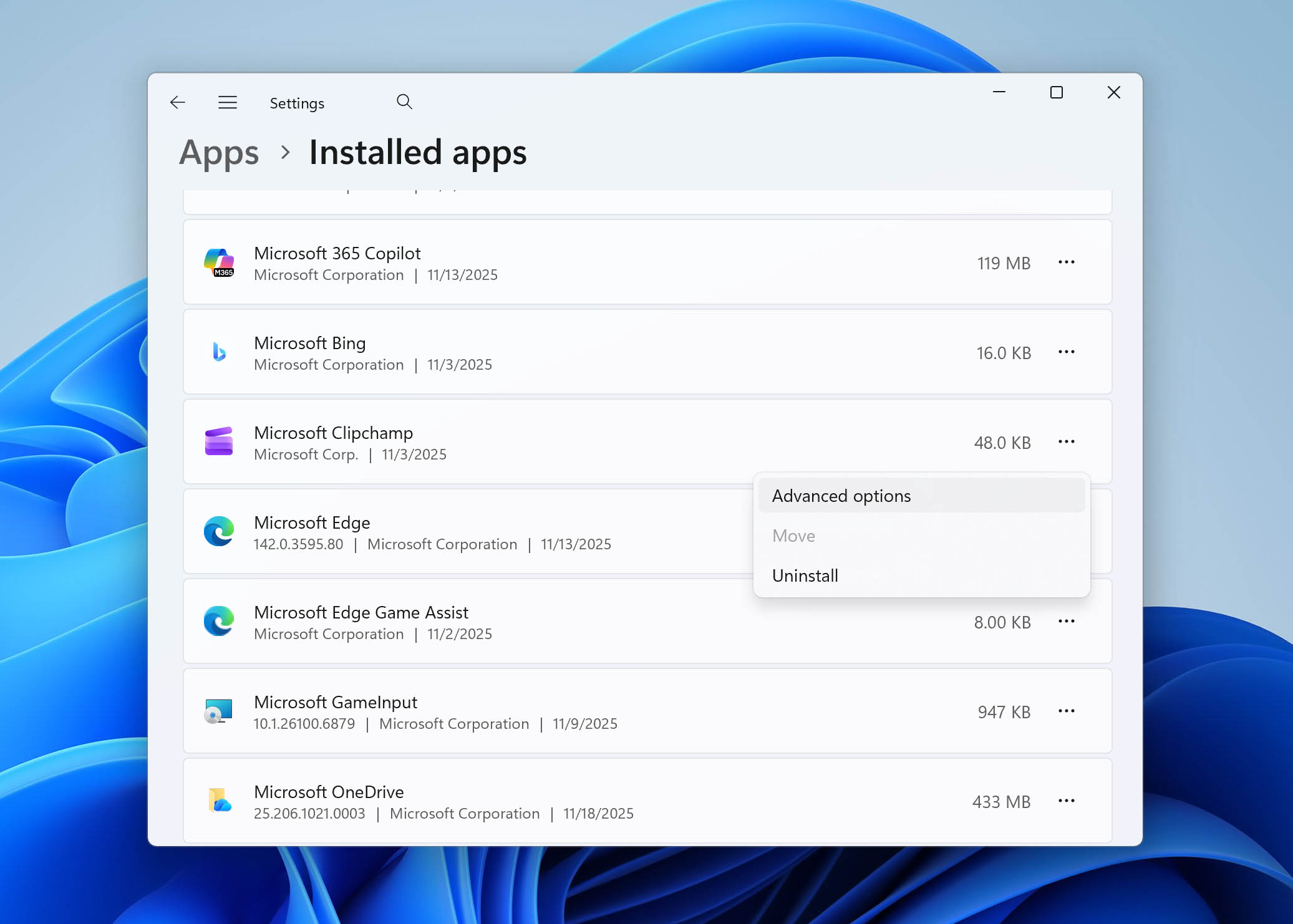
- Scroll down and you’ll see two buttons: Repair and Reset. Click Repair first. Wait until the process finishes. If that doesn’t help, click Reset to fully refresh the app.
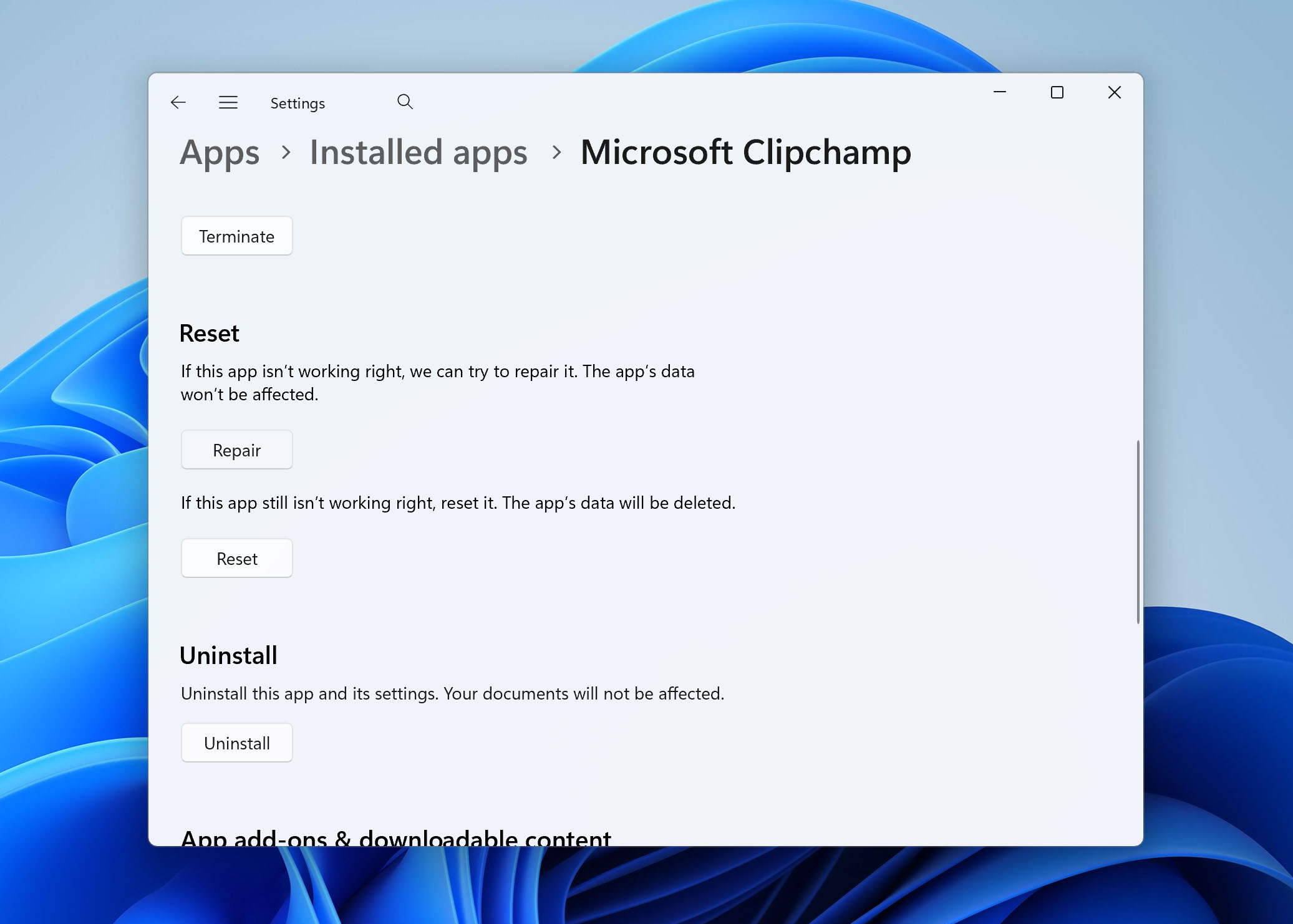
- After that, try launching the app again. In many cases, this simple step clears the file system error and restores normal functionality.
[ You can uninstall and reinstall some Windows apps. If you’ve already removed an app and lost some of its data, check out our guide on how to recover uninstalled programs (it explains how to bring back deleted files or related app data).
Method 7: Change the Sound Scheme
It might sound odd, but some file system errors can actually be linked to missing or corrupted sound scheme files in Windows. These small audio clips (the ones you hear when an error pops up, a notification arrives, or the system starts) are tied to system actions. After running tools like CHKDSK or after certain Windows updates, a few of these sound files can disappear or become unreadable. When that happens, Windows may try to play a sound that no longer exists, triggering a file system error instead.
Restoring the sound scheme to its default settings replaces any missing entries and resets the system’s reference paths for these audio files. So, try this:
- Open Start and search for Control Panel, then open it.
- Click Hardware and Sound.
- Click Sound.
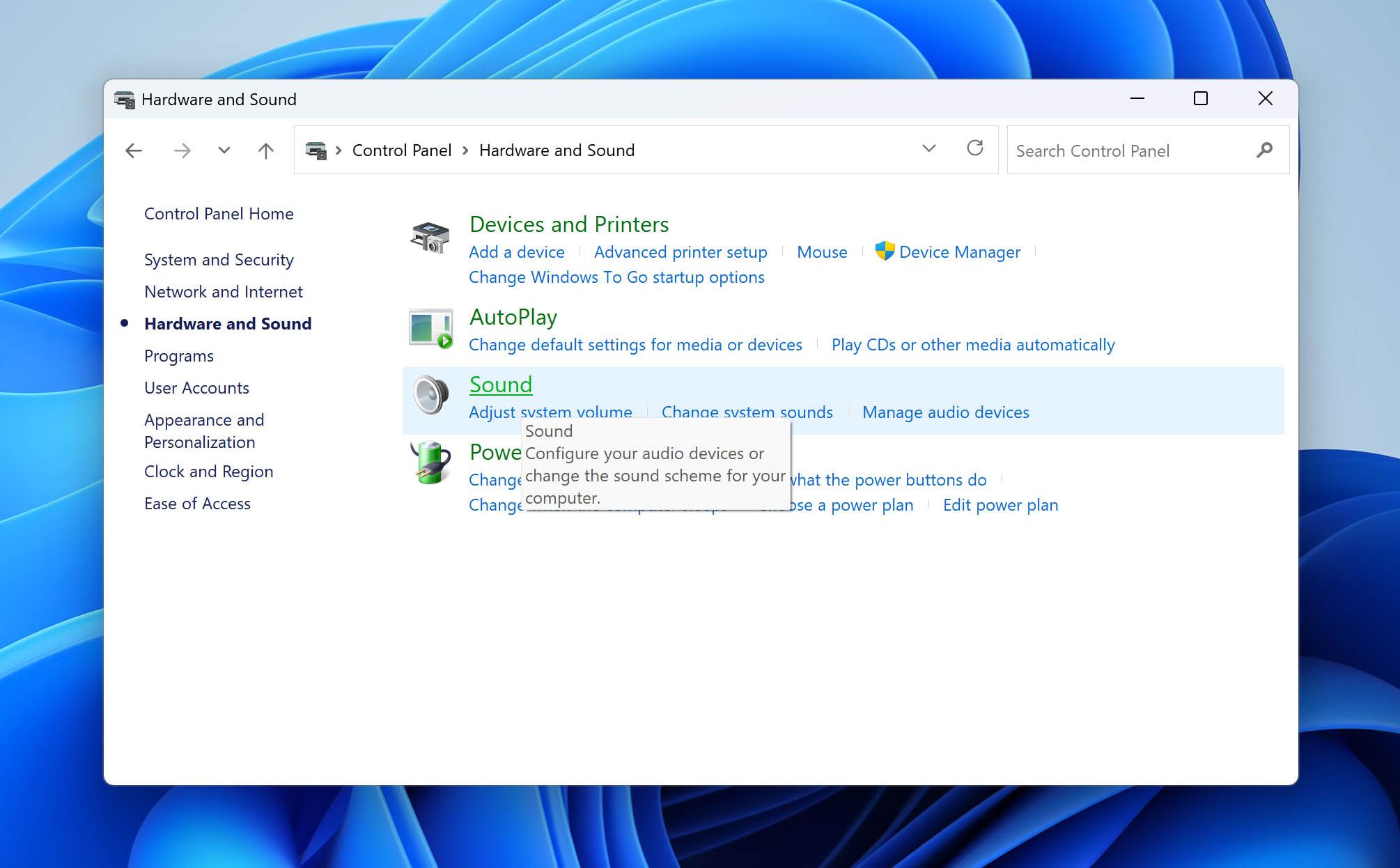
- In the Sounds tab, open the Sound Scheme dropdown and select Windows Default.
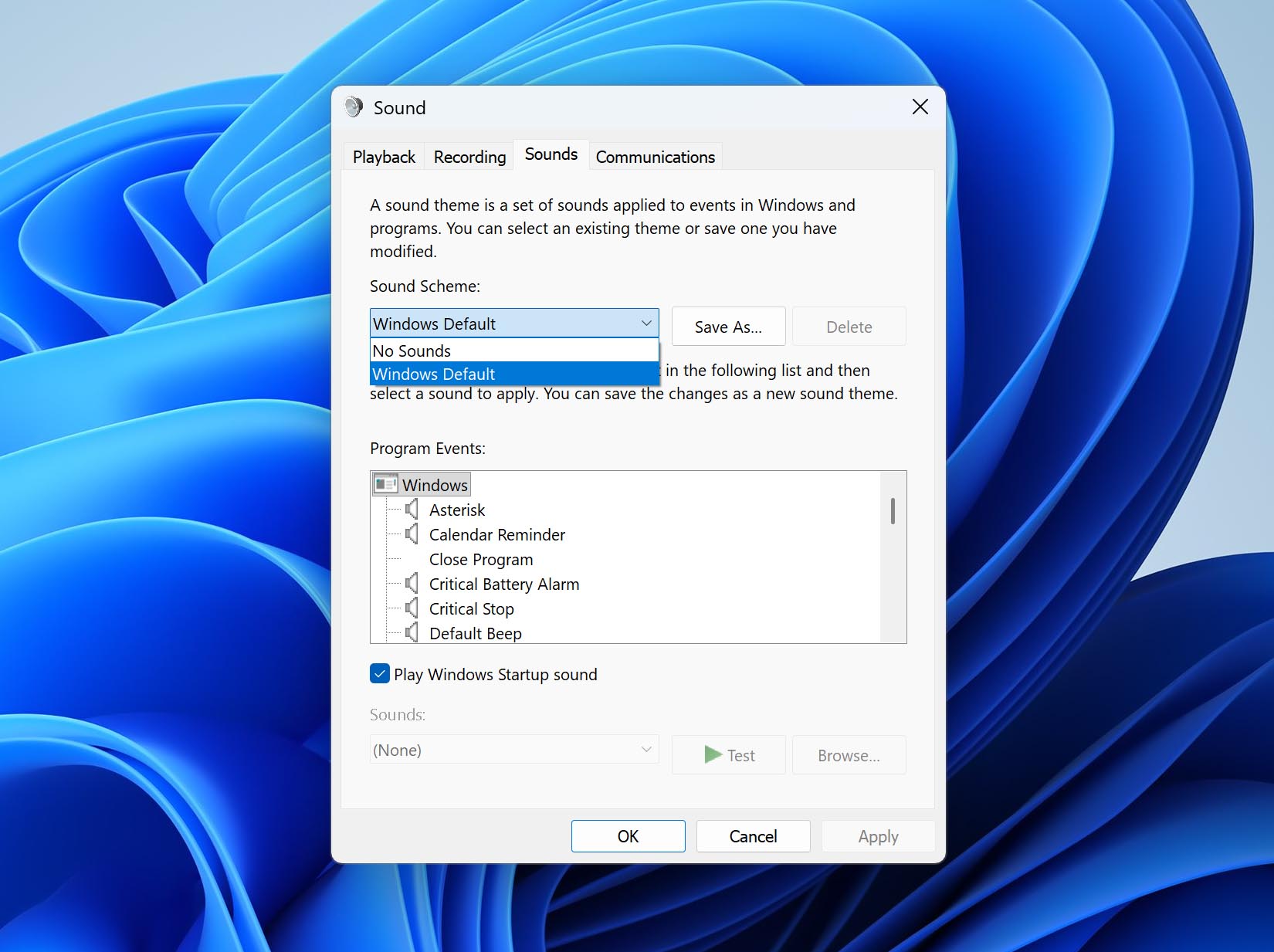
- Click Apply, then OK.
Afterward, restart your PC and check if the file system error still appears. If the message disappears, the issue was most likely caused by a corrupted or missing sound file.
Method 8: Create a New Admin Account
If you’ve tried all the fixes above and the file system error keeps showing up, it might no longer be a system issue and could be tied to your user account.
Sometimes, Windows profiles become misconfigured or lose proper permissions. When that happens, the system may block certain actions, like opening Settings, installing updates, or accessing protected folders, even if you technically have admin rights. As a result, you see repeated file system errors that don’t go away no matter what you fix elsewhere. The easiest way to test this is by creating a new administrator account (if the error disappears there, you’ll know the problem was linked to your old profile).
- Right-click Start and click Settings.
- Click Accounts.
- Click Other Users.
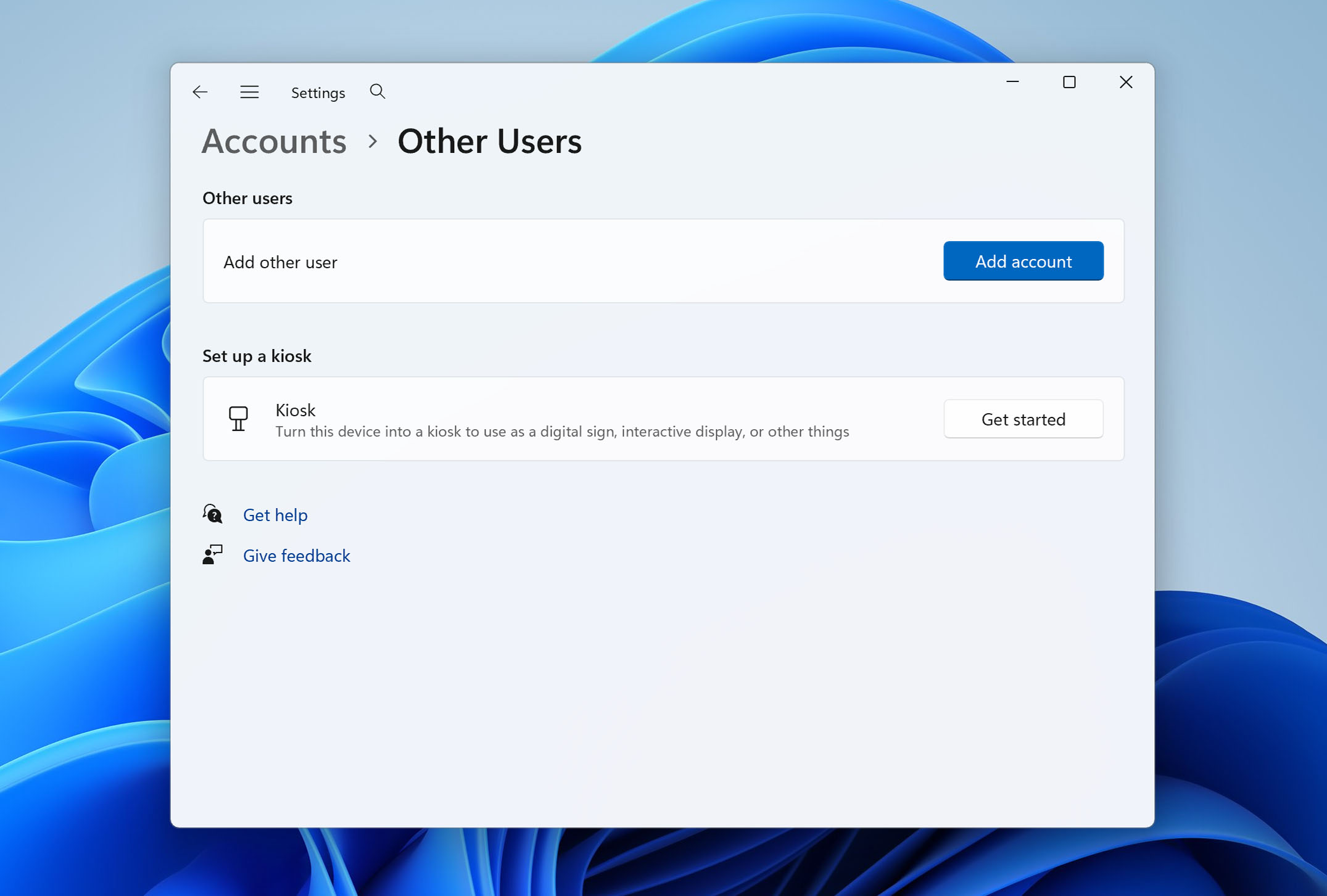
- Click Add account.
- Click I don’t have this person’s sign-in information.
- Click Add a user without a Microsoft account.
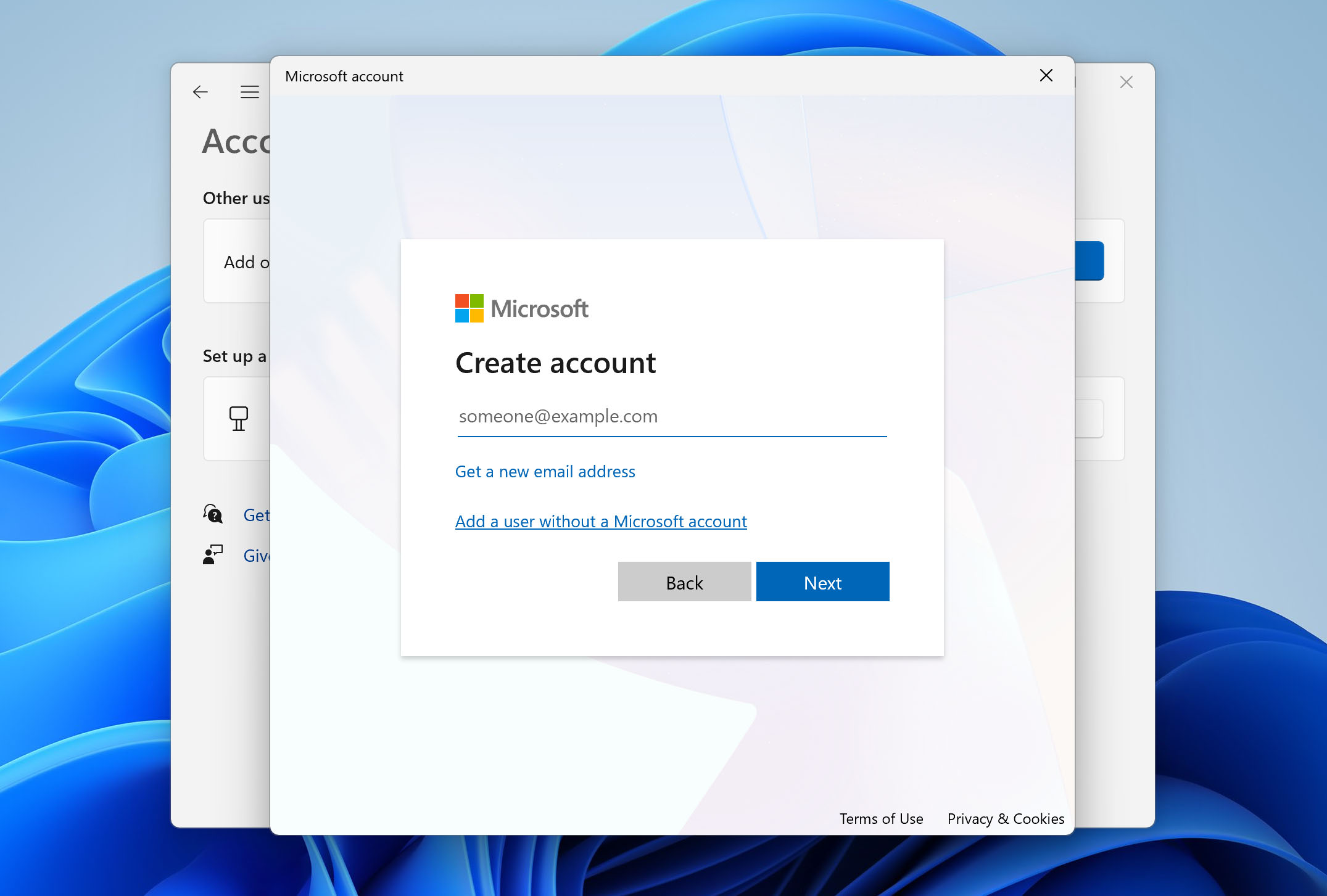
- Give the user a name and password (optional, but recommended). Click Next.
- Click the dropdown of the new user and click Change account type.
- Change the account type from Standard User to Administrator. Click OK.
Now, log in to this new account and try performing the same action that previously triggered the file system error. If everything works normally, your old user profile was the issue, and you can safely move your files to the new one.
Method 9: Restore Windows to an Earlier Date
System Restore is a Windows tool that takes a snapshot of your system and allows you to restore the system to that point in time if you choose to do so. Restoring from a restore point won’t affect your personal files, but it will remove any apps, drivers, or updates that you installed between the restore point and now.
By default, Windows creates one restore point every day once certain actions are performed. Such actions include installing software or applications, installing or updating drivers, and manually creating a restore point. It’s possible to fix the file system error by restoring to a point in time when your computer was running normally. Here’s how:
- Open Start and search ‘Control Panel’. Open it.
- Click Recovery (you may need to change the view to small or large icons in the top right).
- Click Open System Restore.
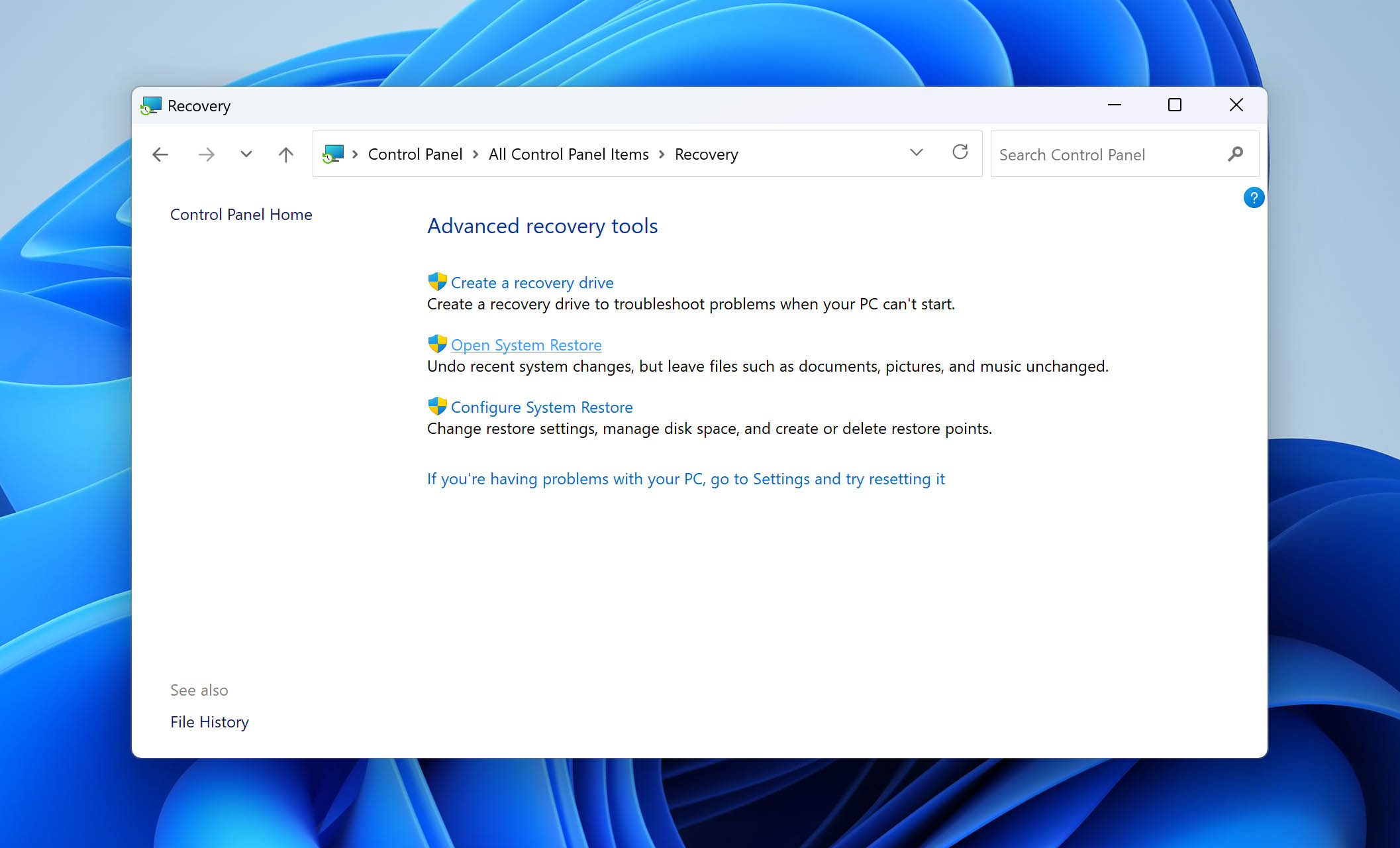
- Click Next.
- Select the restore point and click Next.
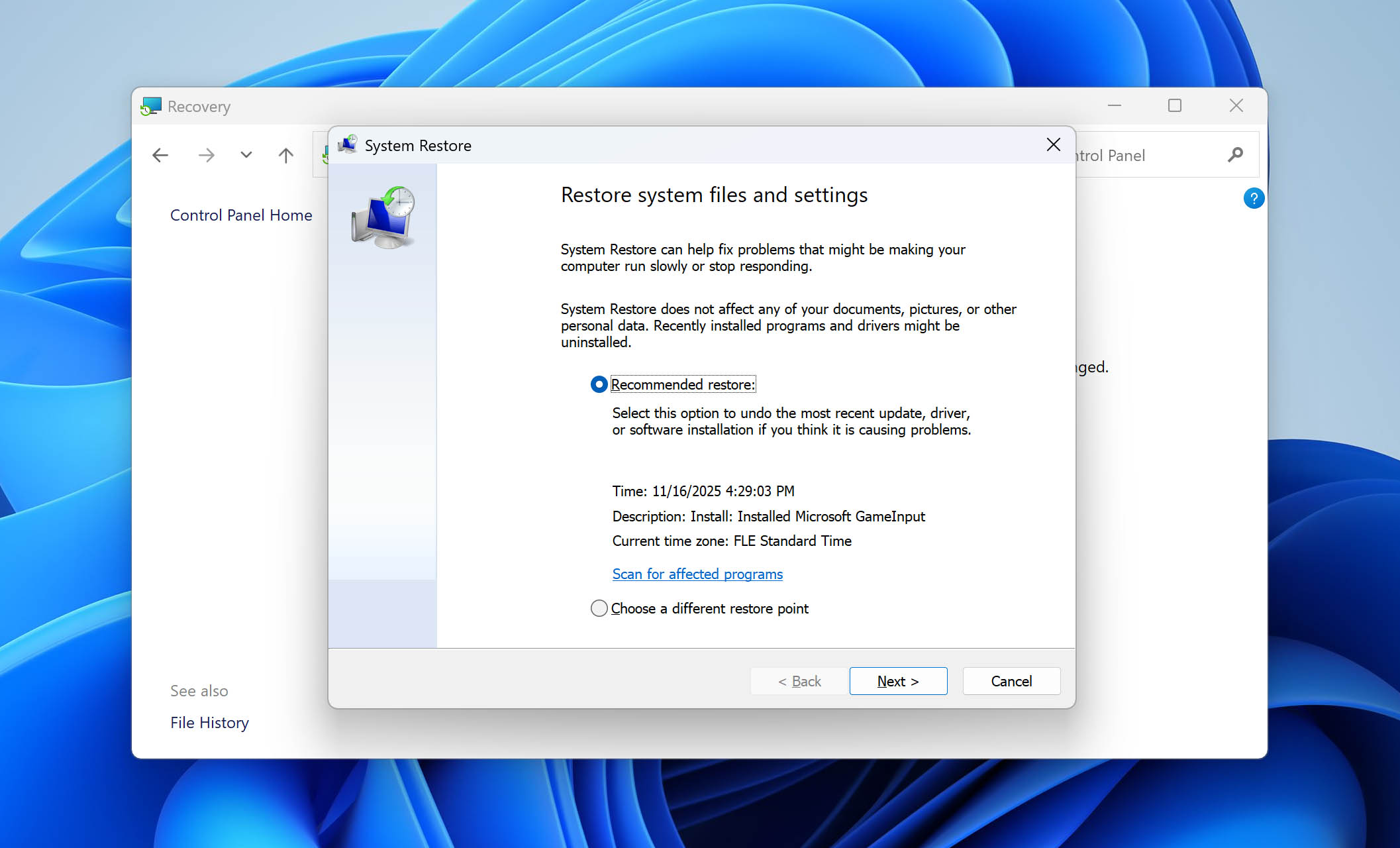
- Click Finish.
[System Restore only works if System Protection is enabled on your computer. If it was turned off, Windows won’t have any restore points to go back to. We recommend activating System Protection now so that you’ll have restore points available in the future.
Method 10: Reset Windows
If none of the solutions presented so far have worked, you can always reset Windows to get rid of file system errors that are extra persistent. You can do this by performing a clean install using a bootable USB, but we’re going to show you how you can do it within Windows if you don’t want to go through the extra hassle.
Even though Windows gives you an opportunity to keep your data, we recommend making a manual backup of your files externally just in case something goes wrong with the reset process.
Here’s how you reset Windows 10 and 11:
- Open Start and search ‘Reset this PC’. Open it.
- Click Reset PC.
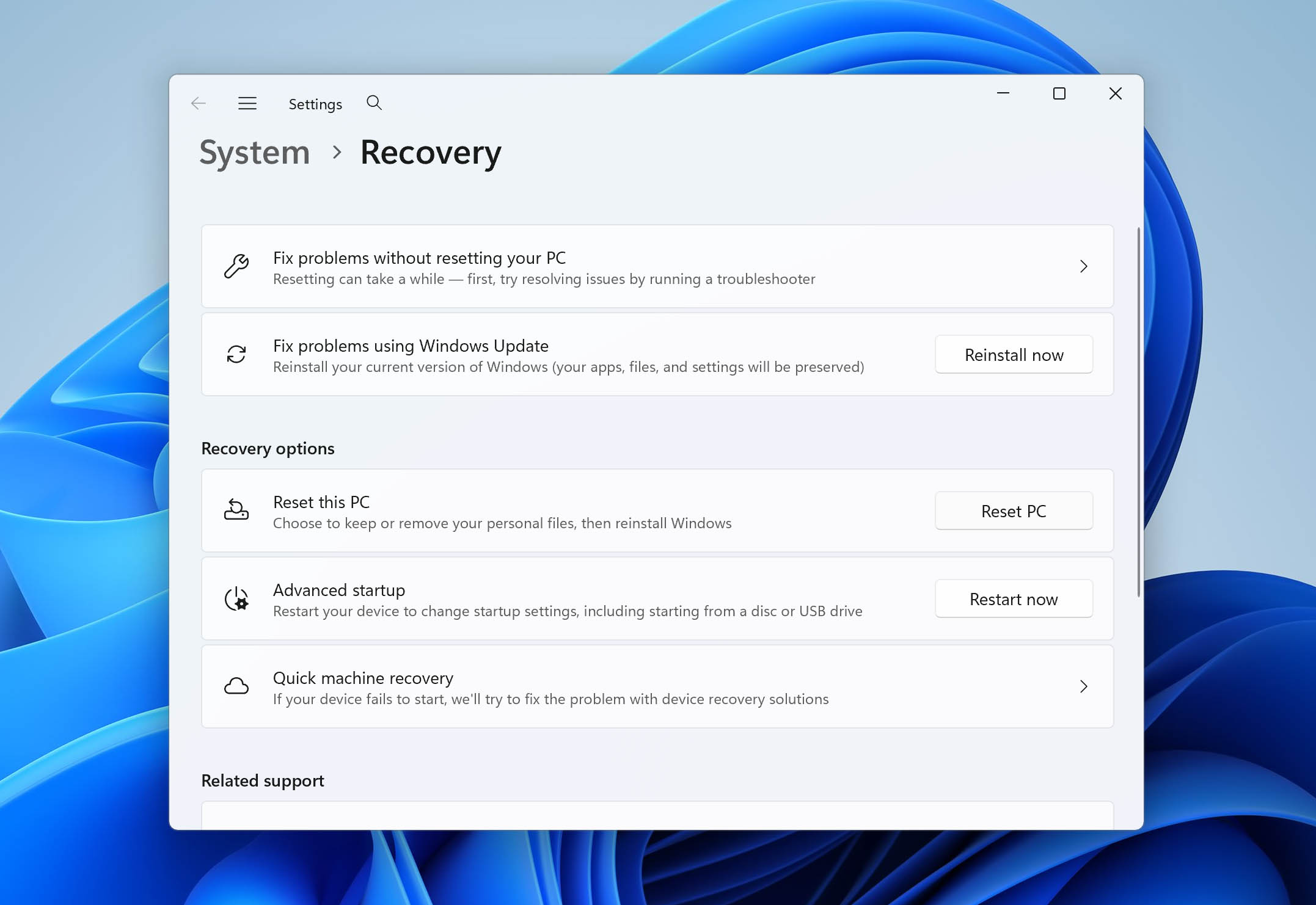
- Click Keep my files or Remove everything, depending on what data you want to keep.
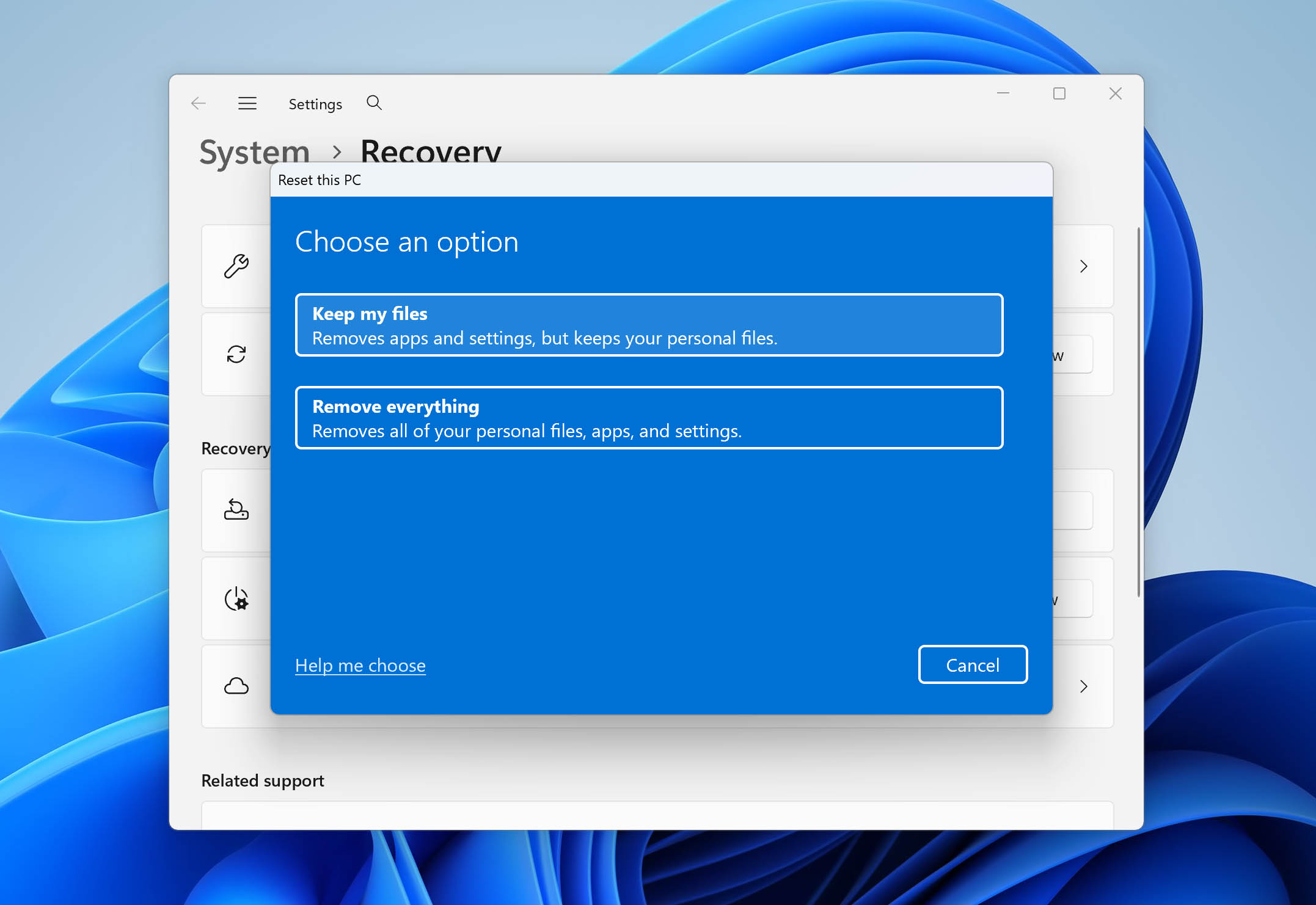
- Follow the on-screen instructions to reset your Windows computer.
Conclusion
In this guide, we’ve covered ways to fix file system errors that can appear on Windows at almost any time. Sometimes a single method is enough to solve the problem, while other times you might need to try several, or even go as far as resetting Windows completely.
Whatever your case is, it’s always best to think about your data first. Before applying any major fix, make sure to copy your important files to a safe place or create a full byte-to-byte backup using Disk Drill, as we showed at the beginning of this article. That way, you’ll never have to worry about losing valuable data in the process.
Looking ahead, it’s a good idea to:
- Keep System Protection turned on so you always have restore points.
- Run regular backups to an external drive or the cloud.
- Avoid shutting down your PC during updates or disk checks (that’s when most file system issues occur).
We’d also love to hear from you, whether it’s your feedback on this guide, a suggestion, or a question that came up while reading. Your experience can help others who face the same problem, so feel free to share it in the comments.
FAQ
- Right-click Start and click Installed apps.
- Click the ellipses button on Microsoft Photos, then click Advanced options.
- Click Repair. If repairing didn’t work, proceed to the next step.
- Click Reset, but bear in mind that this will reset the app’s data too.
- Right-click Start. Open Terminal (Admin).
- Type chkdsk *: /r. Replace * with your drive letter.
- Press Enter.

